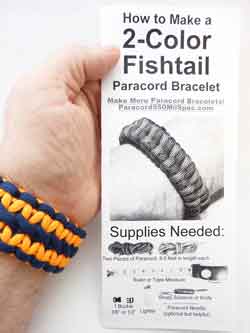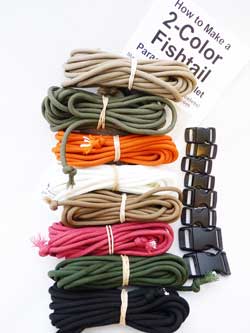Paracord
What is Paracord 550?
What is paracord? Paracord is an inexpensive, readily available lightweight rope, initially developed by the United States military in World War II, where it was used for parachute suspension lines to attach a parachute canopy to the parachute harness. It was also used to attach equipment to harnesses, secure equipment together or onto vehicles, to tie camouflage nets to trees or vehicles, and a huge variety of other “tying” and “binding” applications. It boasts of a truly remarkable breaking strength, sometimes in excess of 550 pounds, especially relative to its small diameter, which is typically around 1/8th or 5/32nd of an inch.
Paracord, also referred to as “Parachute Cord, “Paracord 550,” “550 Paracord,” “Military cord,” “Survival Cord,” or even “550 Cord” is a type of braided or “kernmantle” rope. This means that Paracord is made up of an “inner core” or “kern” of typically twisted nylon or polyester fibers, and a braided “outer sheath” or “mantle,” also typically made up of nylon or polyester. The outer “mantle” encloses and protects the inner “kern.”
Paracord is now manufactured in two general varieties:
(1) “Mil-Spec” paracord – made from 100% nylon, is stronger and more reliable than “commercial” paracord because it is manufactured to the very tightly defined requirements in the nineteen-page Military Specification C-5440H.
(2) “Commercial” paracord – made from nylon, polyester, or a combination of the two, and not manufactured to any one particular manufacturing or quality control standard. Commercial paracord is often incorrectly represented to be, or suggested to be, “MilSpec Paracord,” “Real Paracord,” or “as good as” MilSpec Paracord.
Most people would find it impossible to determine the difference between Mil-Spec and Commercial Paracord, especially without special training, information or tools. However, there are four simple and easy observations a lay person can make to help highlight the differences.
Mil-Spec Paracord continues to be used on both military and civilian parachutes today, as well as for a gigantic variety of other uses. The Parachute Industry Association adopted their Paracord manufacturing specification from the Mil-Spec C-5040H, and has continued to update their specification that they call: PIA C-5040E.
The small size, portability, affordability, versatility and exceptional breaking strength have resulted in 550 Paracord becoming a popular and favorite item for everyday use by military, paramilitary, rescue, law enforcement and construction workers. Everyday civilian people, sportsmen as well as hobbyists, at home and on the job, appreciate the convenience and multiple applications of paracord. Some refer to Paracord as “the Swiss Army Knife” of rope.
550 Type III Paracord
Paracord is very often referred to as “550 Paracord,” “Paracord 550,” “550 Cord,” “550 Parachute Cord,” as well as other paracord names that have “550” in them. This nomenclature has evolved from the Mil-Spec C-5040H, which defines very specifically a minimum (not an average) breaking strength of 550 pounds.
Military specification compliant, Type III Paracord must have a minimum breaking strength of at least 550 pounds, and must be documented for audit by the military at any time.
Commercial paracord, also often referred to with the “550” in the name, may or may not actually have a documented breaking strength of a minimum of 550 pounds because it is not manufactured to any one particular manufacturing or quality control standard.
Additionally, by far, the most frequently referred to “type” or “category” of paracord is “Type III” paracord. The nomenclature for this “type” of paracord has also evolved from the Mil-Spec C-5040H, which defines six different “types” or “categories” of paracord. These different “types” include:
Type I
Type IA
Type II
Type IIA
Type III
Type IV
Each of these different types of paracord, as defined by the Mil-Spec C-5040H, has a different manufacturing standard. However, “Type III” paracord is clearly the “type” of paracord that most people are referring to when they talk about “Paracord” or “Parachute Cord.”
550 Type III Paracord – Break Strength
The break strength for Type III Mil-Spec Paracord is required to be a minimum of 550 pounds. Hence the name 550 Type III Paracord. However, again, “commercial” paracord, often referred to as “Type III,” probably has been manufactured consistently with SOME of the requirements of Mil-Spec C-5040H for Type III Paracord. However, because there is no single manufacturing standard for “commercial” paracord, ALL of the requirements for Mil-Spec C-5040H have not been met.
As such, when “commercial” paracord is referred to as: “Type III” and “550,” it is generally an attempt to make the cheaper “commercial” sound like the more expensive and reliable “Mil Spec” Paracord. Buyer beware because there is a difference especially if you were expecting the strength of 550 Type III Paracord.
Commercial Paracord
“Commercial” paracord is essentially a less expensive, and sometimes considered to be a “cheap knockoff” of “original” paracord, or “real” or “Mil-Spec” Paracord.
The biggest challenge with commercial paracord is that it is simply not manufactured to any single agreed-upon manufacturing and quality control standard. So manufacturers of commercial paracord make paracord significantly differently from each other.
Some manufacturers make paracord to a “higher” standard, and other manufacturers make paracord to a “lower” and “cheaper” standard. The differences between “higher quality” commercial paracord and “lower quality” commercial paracord are essentially impossible for a “normal, regular” person to determine. As such, there are now many manufacturers of “cheap” paracord selling miles of paracord both online and in retail stores.
Commercial Paracord – Colors and Description Cues
Commercial paracord is manufactured in a large variety of different colors, and is regularly marketed very suggestively as: “as good as,” “the same as,” or even “better than” Mil-Spec Paracord. Manufacturers and marketers of commercial paracord regularly describe their commercial paracord with official-sounding accolades, such as:
– manufactured by a certified U.S. Government contractor
– official military manufacturer
– authentic commercial Paracord
– official military paracord rope
– GSA compliant
– better than military specifications
– made and tested in the United States
– U.S. Made Military paracord 550
– super strong military issue
– Type III 550
To be sure, none of the above artificial accolades in and of themselves define whether paracord IS or IS NOT compliant with Mil-Spec C-5040H.
For example, paracord that is “manufactured by a certified U.S. Government contractor” or made by an “official military manufacturer” may or may NOT be compliant with Mil-Spec C-5040H. Certainly one of the requirements of Mil-Spec C-5040H, and especially The Berry Amendment, is that the Paracord must be manufactured in the United States. However, there are many “certified U.S. Government contractors” and “official military manufacturers” of Mil-Spec C-5040H Paracord who ALSO make commercial paracord, manufactured to any standard that they choose.
(You can download a copy of the Mil-Spec C-5040H from this link.)
Perhaps because of the increase in the numbers of “cheap” paracord manufacturers, the Number One discussion on internet forums, chat rooms, and e-commerce websites that have customer reviews available (e.g.: Amazon), is whether any given paracord is “real” paracord, or “Mil-Spec” paracord, “Mil-Spec C-5040” paracord, Mil-Spec C-5040H” paracord; OR … is the “cheap stuff” or “cheap commercial”paracord.
Quite simply, Paracord either IS … or IS NOT compliant with the Mil-Spec C-5040H. So there is technically no such thing as “commercial mil-spec” paracord.
The MANUFACTURERS who actually MAKE Mil-Spec compliant Paracord know for certain what the requirements are, and that their Paracord is compliant. These manufacturers who presently sell Paracord to the United States military are also audited by Military inspectors who are quite strict about the manufacturing compliance for their Paracord.
Making false or incorrect claims about whether Paracord IS or IS NOT compliant with the Military Specification is a serious issue. There are reports available of people being incarcerated for attempting to sell MilSpec compliant paracord to the United States military that was not, in fact, compliant with MIL-C-5040.
Manufacturers who make genuine MilSpec compliant paracord will readily make their “compliance” documentation available, sometimes in the form of a document called a: Manufacturer’s Physical Materials Analysis Certificate.
If the manufacturer or marketers of paracord merely suggest that their paracord is “real” Mil-Spec paracord, as with the official-sounding accolades above, it can be safely assumed that the paracord is NOT “real” Mil-Spec Paracord. If it WERE compliant with the Mil-Spec C-5040H, the manufacturers and marketers would know for sure and would definitely state this fact very specifically.
The next challenge, then, becomes with the very many disreputable manufacturers and marketers who just outright claim, either out of ignorance blatant dishonesty, that their paracord IS “Mil-Spec” Paracord when it is not.
Certainly most of the requirements of the Mil-Spec C-5040H would be impossible for a “regular, normal” person to determine just by looking at their paracord.
However, there are FOUR easily learned observations that a “lay” person can use to determine: that their paracord PROBABLY IS Mil-Spec Paracord; OR, that their paracord definitely IS NOT Mil-Spec Paracord.
Check out Kacey’s video about “The Big Four,” or the four easily observed ways that a “normal regular” person could easily determine whether or not their paracord was “real” mil spec paracord, or cheaper commercial paracord.
Often it’s easier to start off with a complete kit for making Paracord Survival Bracelets. This way, you have everything you need, and you can start right off making bracelets, rather than having to find all ofhte materials and supplies that you need.
This is our favorite Paracord Survival Bracelet Kit.
This kit includes:
– 8 different colors of MilSpec C-5040H paracord
– 8 buckles in three different sizes (3/8″, 1/2″ & 5/8″)
– a set of written instructions
– links to this website for more instructions for

making Paracord Survival Bracelets.
There are enough materials in this kit to make at least 8 Paracord Survival Bracelets of 1, 2 or even 3 colors.






